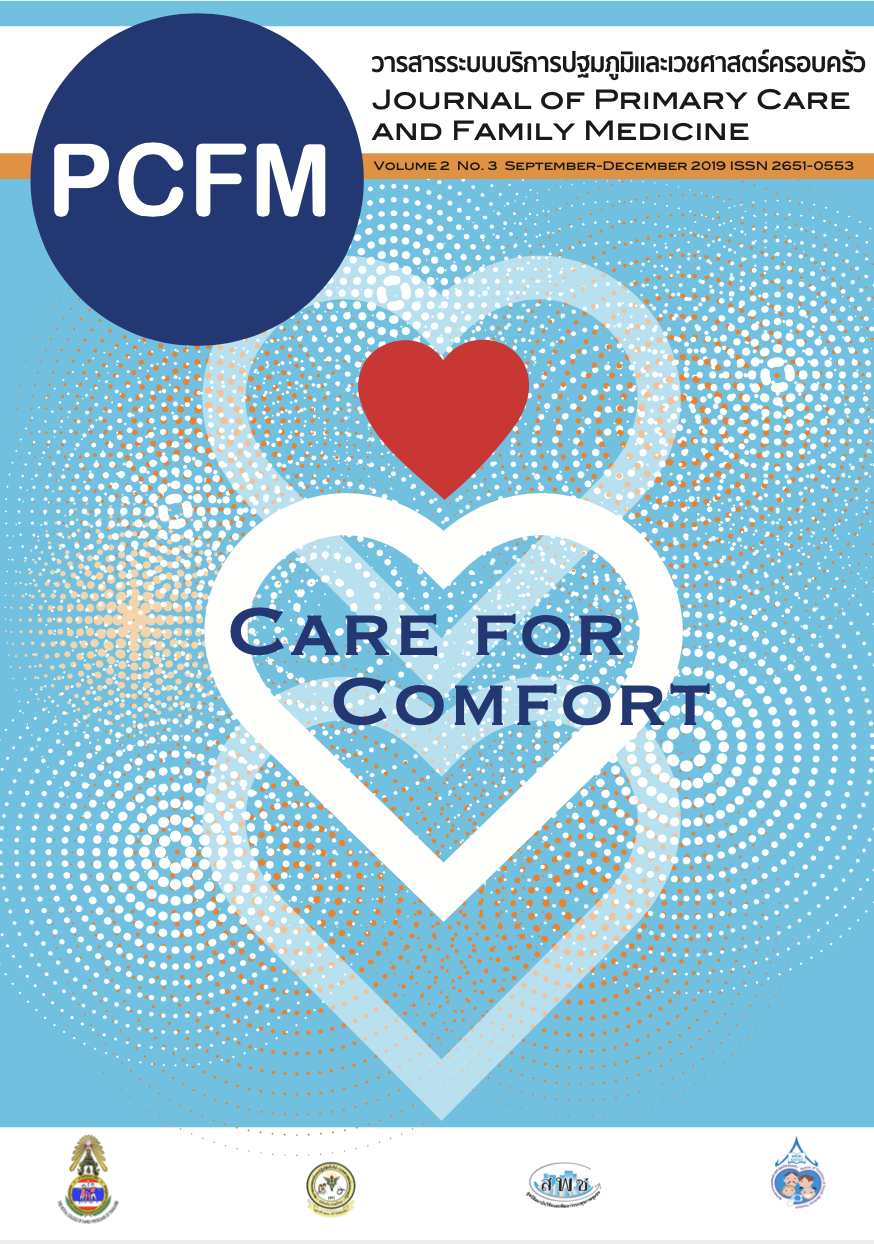ความสัมพันธ์ระหว่างความผิดปกติของระบบประสาทส่วนปลายบริเวณเท้าในผู้ป่วยโรคเบาหวานชนิดที่ 2 กับการทรงตัวและความเสี่ยงในการหกล้ม -
Main Article Content
บทคัดย่อ
ที่มาและความสำคัญ: ความผิดปกติของระบบประสาทส่วนปลายบริเวณเท้า(DN)เป็นภาวะแทรกซ้อนจากโรคเบาหวานชนิดที่ 2(T2DM) มีผลกระทบต่อผู้ป่วย อาจทำให้หกล้ม วัตถุประสงค์เพื่อศึกษาความสัมพันธ์ระหว่าง DN และปัจจัยเสี่ยงอื่นใน T2DM กับการทรงตัวและความเสี่ยงในการหกล้ม
วิธีการศึกษา: การวิจัยเชิงปริมาณภาคตัดขวาง ในผู้ป่วยT2DM อายุ 18 ปีขึ้นไป จำนวน 120 คน ที่มารับบริการที่คลินิกผู้ป่วยนอกช่วง 1 กุมภาพันธ์ – 31 พฤษภาคม 2562 ใช้แบบสัมภาษณ์, แบบประเมิน The Michigan Neuropathy screening Instrument, ทดสอบ Timed Up and Go Test (TUG)และSingle leg stance test (SLS) หาความสัมพันธ์ระหว่าง DN ในผู้ป่วย T2DM และปัจจัยเสี่ยงอื่น วิเคราะห์โดยสถิติ multivariate analysis (p-value < 0.05)
ผลการศึกษา: พบว่า DN ในผู้ป่วยT2DM สัมพันธ์กับการทรงตัวและความเสี่ยงในการหกล้ม SLS (adjusted OR: 23.1; 95% CI 2.09 – 255.22; p=0.01) และ TUG(adjusted OR: 41.3; 95% CI 9.83 – 173.61; p < 0.001) และพบว่า เพศหญิง, ไขมันในเลือดสูง, ความดันโลหิตสูง, เข่าเสื่อม, ต้อกระจก, ปัญหาสายตา, กลัวการหกล้ม, ใช้ยานอนหลับ, อายุ, ระยะเวลาของT2DM เป็นปัจจัยเสี่ยงต่อการหกล้ม
สรุปผล: DN ในผู้ป่วย T2DM มีความสัมพันธ์กับการทรงตัวและความเสี่ยงในการหกล้ม ผู้ป่วยT2DMและDN ควรได้รับการประเมินการทรงตัวและความเสี่ยงในการหกล้ม
Article Details
เนื้อหาและข้อมูลในบทความที่ลงตีพิมพ์ในวารสาร PCFM ถือเป็นข้อคิดเห็นและความรับผิดชอบของผู้เขียนบทความโดยตรง ซึ่งกองบรรณาธิการวารสารไม่จำเป็นต้องเห็นด้วยหรือร่วมรับผิดชอบใด ๆ
บทความ ข้อมูล เนื้อหา รูปภาพ ฯลฯ ที่ได้รับการตีพิมพ์ลงในวารสาร PCFM ถือเป็นลิขสิทธิ์ของวารสาร PCFM หากบุคคลหรือหน่วยงานใดต้องการนำทั้งหมดหรือส่วนหนึ่งส่วนใดไปเผยแพร่ต่อหรือเพื่อกระทำการใด ๆ จะต้องได้รับอนุญาตเป็นลายลักษณ์อักษรจากวารสาร PCFM ก่อนเท่านั้น
References
2. International Diabetes Federation. IDF diabetes atlas [Internet]. 8th ed. 2017 [cited 2018 August 12]. Available from: https://www.idf.org/e-library/epidemiology-research/diabetes-atlas/134-idf-diabetes-atlas-8th-edition.html
3. Papatheodorou K, Papanas N, Banach M, Papazoglou D, Edmonds M. Complications of Diabetes 2016. J Diabetes Res 2016. doi.org/10.1155/2016/6989453
4. Juster-switlyk K, Smith AG; Department of Neurology University of Utah School of Medicine Salt Lake City UT USA. Updates in diabetic peripheral neuropathy. F1000Res. 2016;5. doi:10.12688/f1000research.7898.1
5. Rangsing R, Tassanawiwat P, et al. Data Collection and analysis for care among Patients Diagnosed with Type 2 Diabetes and Hypertension Visiting Hospitals in care of Ministry of Public Health and Hospital in Bangkok in Thailand 2015. national health security office. 2015.
6. UC Berkeley school of public health. Why diabetes raises your risk of falling. [Internet]. 2017 [cited 2017 Nov 3]. Available from: https://www.healthandwellnessalerts.berkeley.edu/alerts/diabetes/Why-Diabetes-Raises-Your-Risk-of-Falling_7805-1.html
7. Damri T, Chatchawan U. validity and reliability of the michigan neuropathy screening instrument (MNSI) on the diabetic type II patients (Thai version). JMTPT 2015; 27: 307-319.
8. Tinetti ME, Richman D, Powell L. Falls efficacy as a measure of fear of falling. J Gerontol B Psychol Sci Soc Sci 1990; 45(6): 239-43.
9. Podsiadlo D, Richardson S. The time “Up & Go”: a test of basic functional mobility for frail elderly persons. J Am Geriatr Soc 1991; 39: 142-8.
10. Eckstrom E, Parker EM, Shakya I, Lee R. Coordinated Care Plan to Prevent Older Adult Falls. Atlanta, GA: National Center for Injury Prevention and Control, Centers for Disease Control and Prevention, 2019.
11. Jonsson E, Seiger A, Hirschfeld H. One-leg stance in healthy young and elderly adults: a measure of postural steadiness?. Clinical biomechanic 2004; 19: 688-94.
12. Bradley GB, DAVIS KA; Southern Illinois University School of Medicine Decatur Illinois. Orthostatic Hypotension. American Family Physician 2003; 68: 2393-98.
13. Yang Y, Hu X, Zhang Q, Zou R. Diabetes mellitus and risk of falls in older adults: a systematic review and meta-analysis. Age and Ageing 2016; 45(6): 761-67.
14. Timar B, Timar R, Gaită L, Oancea C, Levai C, Lungeanu D. The Impact of Diabetic Neuropathy on Balance and on the Risk of Falls in Patients with Type 2 Diabetes Mellitus: A Cross-Sectional Study. PLoS ONE 2016; 11(4): Diabetes Mellitus: A Cross-Sectional Study. PLoS ONE 11(4): e0154654. doi:10.1371/journal.pone.0154654.
15. Schwartz AV, Hiller TA, Sellmeyer DE, Resnick HE, Gregg E, Ensrud KE, et al. Older Women With Diabetes Have a Higher Risk of Falls. Diabetic care 2002; 25(10): 1749-54.
16. Harwood RH. Visual problems and falls. Age and Ageing 2001; 30-S4: 13–18.
17. Bruce D, Hunter M, Peters K, Davis T, Davis W. Fear of falling is common in patients with type 2 diabetes and is associated with increased risk of falls. Age and Ageing 2015; 44(4): 687–90.
18. Diem SJ, Ewing SK, Stone KL, Ancoli-Israel S, Redline S, Ensrud KE, Use of non-benzodiazepine sedative hypnotics and risk of falls in older men. J Gerontol Geriatr Res 2014; 3(3). 2014; 158. doi:10.4172/2167-7182.1000158.
19. Kim KS, Kim SK, Sung KM, Cho YW, Park SW.Management of Type 2 Diabetes Mellitus in Older Adults. Diabetes & Metabolism Journal 2012; 36(5): 336-44.
20. Tilling LM, Darawil K, Britton M, Falls as a complication of diabetes mellitus in older people, J Diabetes Complications 2006, 20(3): 158–162.
21. Macgilchrist C, Paul L, Ellis BM, Howe TE, Kennon B, Godwin J, Lower-limb risk factors for falls in people with diabetes mellitus, Diabetic Medicine 2010, 27(2): 162–168.
22. Crews RT, Yalla SV, Fleischer AE, Wu SC. A Growing Troubling Triad: Diabetes, Aging, and Falls. J of Aging 2013, 342650. doi.org/10.1155/2013/342650.
23. Mirkovic VB, Karanikic ZS, Nejkov S, Vukovic M, Cirovic D. Diabetic Polyneuropathy and risk of falls: fear of falling and other factors. Acta Clin Croat 2017; 56: 721-727

